 |
[ Outlaw Genealogy | Bruce
History | Lost Chords ] [ Projects | News | FAQ | Suggestions | Search | HotLinks | Resources | Ufo ] |
 |
[ Outlaw Genealogy | Bruce
History | Lost Chords ] [ Projects | News | FAQ | Suggestions | Search | HotLinks | Resources | Ufo ] |
Hanseatic League History
I was looking for some record to directly link the Hanse guild to the
Outlawe's, several Outlawe ships were used to transport goods to Danzig and
Lubeck is clear...
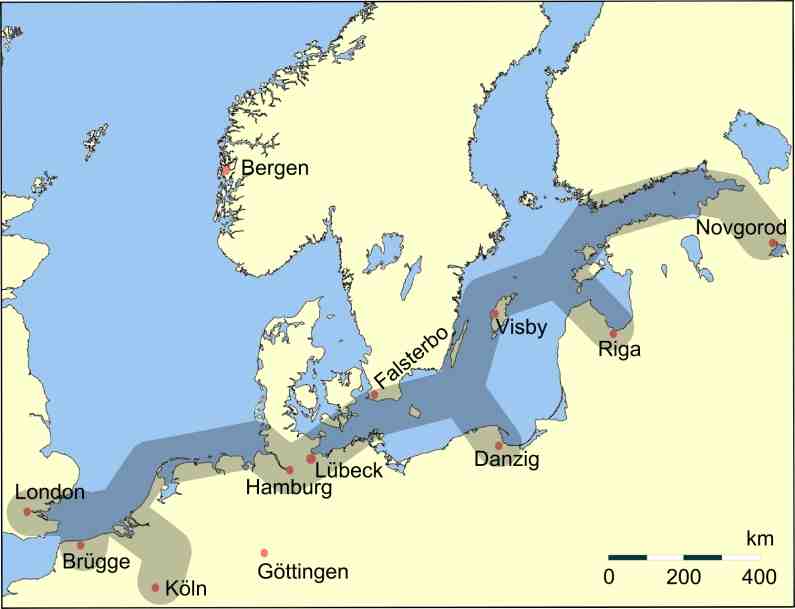 King's Lynn -
Hanseatic town guide to King's Lynn - Hanse.org
King's Lynn -
Hanseatic town guide to King's Lynn - Hanse.org
The Norfolk town accepted them as “the fraternity of the German Hanse” (fratres de hansa alemanies in Anglia existentes, Lynn 1302) ....
Lynn merchants sent cargoes to Prussia in Danzig ships and to Bergen in Lübeck bottoms, but none of them appear to have been resident in Norway or Hanseatic cities until the 1380s. Lynn was soon more heavily dependent on the Prussia trade through Danzig than any other English port. ...
The Treaty of Utrecht was signed in 1474 and the English King conveyed a quay and tenements in the Norfolk town to the Hanse. Lübeck invited Danzig to take charge of the property, the complex now known as St Margaret’s House. This is today the only surviving Hanseatic business headquarters or steelyard in England ...
In 1537 Bishop’s Lynn became King’s Lynn when the charter of Henry VIII finally dispossessed the Norwich bishops and transferred full political power to the town’s merchants.
Hanseatic League - The Hanseatic League (also known as the Hanse or Hansa) was an economic alliance of trading cities and their guilds that dominated trade along the coast of Northern Europe in the later Middle Ages. It stretched from the Baltic to the North Sea and inland during the Late Middle Ages and early modern period (c.13th–17th centuries). The Hanseatic cities had their own legal system and furnished their own protection and mutual aid, and thus established a sort of political autonomy and in some cases created political entities of their own.
Coat of Arms of the Hanse - Merchants of London
Hanse House is situated between the riverbank of the Great Ouse and St. Margaret's Church. The building is of considerable architectural and historic interest and forms a picturesque feature of the street scenery of King's Lynn. The building comprises of Hanseatic warehouses dating from 1475. Built around a narrow court, these large warehouses were owned by Hanseatic League merchants until 1751.
| - - - -
Prince Charles joins campaign to save King’s Lynn’s Hanse House - News - Eastern Daily
Press - Friday, January 14, 2011
The Prince, who is president of the Prince’s Regeneration Trust, will visit Hanse
House, in St Margaret’s Place, in the town’s medieval quarter, on
January 25. - St Margaret’s House, is suffering from years of
neglect....Prince Charles is said to have become concerned about the Hanse House
after hearing that the building was falling into disrepair.
BBC -
Prince of Wales visit to save King's Lynn's Hanse House
Hanseatic
Warehouse
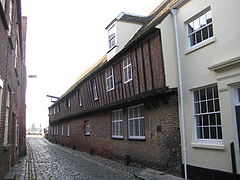 Located
on St Margaret's Lane, the Hanseatic Warehouse (52°45′04″N
0°23′41″E
/ 52.7512°N
0.3946°E / 52.7512;
0.3946 (Hanseatic Warehouse, King's Lynn))
is the only surviving Hansa
building in England. It was constructed in 1475 as part of the Treaty
of Utrecht allowing Hansa to establish a trading depot in Lynn for the first
time. It was used as such until 1751, by which time the river had receded. It
was then sold to Lynn merchant Edward Everard for £800. He added the Georgian
town house at the East side of the building which is now known as St. Margaret's
House (and Grade I listed[25]),
after the nearby church.
Located
on St Margaret's Lane, the Hanseatic Warehouse (52°45′04″N
0°23′41″E
/ 52.7512°N
0.3946°E / 52.7512;
0.3946 (Hanseatic Warehouse, King's Lynn))
is the only surviving Hansa
building in England. It was constructed in 1475 as part of the Treaty
of Utrecht allowing Hansa to establish a trading depot in Lynn for the first
time. It was used as such until 1751, by which time the river had receded. It
was then sold to Lynn merchant Edward Everard for £800. He added the Georgian
town house at the East side of the building which is now known as St. Margaret's
House (and Grade I listed[25]),
after the nearby church.
Archives of the Corporation of the City of London at the Guildhall
Links:
Maritime Topics On Stamps : The Hanseatic League and her ships! , Hanse Cog
The Hanseatic League used the cog as their ship of choice. The cogs were developed from the 'Knorrs' of the Vikings . They had a high-boarded, round, clinker planking hull with a steep stem and straight keel. The length-to-breadth-ratio was three to one. A solid, continuous deck was installed to protect the cargo. The first cogs still had an old rudder on the starboard side which later on was replaced by a stern rudder.
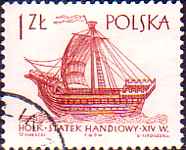
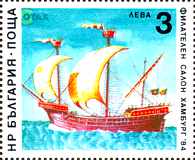
On the stamp to the left you can see a single-masted Hulk (Holk) taken from a seal of the city of Danzig around 1400. From this Dutch type and the previous cogs a three masted ship type was developed, which was at one time called Hulk as well, and at other times 'new version of the cog'.
In the middle of the 15th century these ships got smooth carvel planking, which made them running a lot faster. The top of the mast was replaced with a so-called 'Mars' - a small fort-like platform for additional warriors and weapons. Foremast and main mast were rigged to carry yard sails and the mizzen mast got a lateen sail for a better performance when sailing close-hauled to the wind. These ships had the following data: l - 98 ft, b - 26 ft, d - 10 ft, load-capacity 100 loads translating to 200t, sail area 2700 sqft.
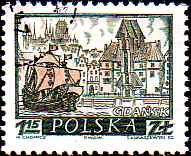
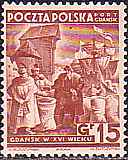
In the 15th century over 1,000 ships with a capacity of approximate 45.000
loads (approx. 90,000 tons) sailed under the flag of the Hanseatic League.
The annual transportation reached more than 200,000 tons. More than 300,000
barrels of fish were shipped from Schonen every year. 1,100 ships left Danzig
carrying grain to the Netherlands and Belgium. The typical crew of cog
consisted of 15 to 20 men and some merchants and their staff. During war
times and in pirate areas a small contingent of soldiers was carried along, the
exact number depending on the ship's size and value. The Hulks could carry
approx. 100 men.
On the stamps you can see ships and merchants in the port of Danzig. The
famous Danziger crane gate can be seen in the background, a loft with an
integrated crane which was already operating at the time of the Hanseatic
League.
1401: Klaus Stortebeker, Victual Brother pirate of the Hanseatic League
On this date in 1401,* “Victual Brother” Klaus Störtebeker was beheaded
in Hamburg. This
legendary freebooter terrorized the Hanseatic
League‘s trading channels from Novgorod to London in the 1390s. He was the most famous of a company of privateers who’d been hired out in
1392 to place their thumb on the scale of Scandinavian dynastic politics** —
notably, supplying Stockholm during a siege, from which service they obtained†
the nickname Victual
Brothers. It stuck, even when operations had moved far beyond the larder.
In the mid-1390s, the “brothers” turned against Danes and Hanse alike,
raiding coasts and plundering
sea trade.
...
The buccaneer’s end, after capture by Simon
of Utrecht, was equally legendary: he’s supposed to have made a scaffold
pact with the headsman to spare any of his mates he could walk past once
decapitated.
London The Forgotten Hanseatic City - Gresham College
Die Hanse (the Hansa - the Hanseatic League) was a northern European
co-operative and alliance of between 70 and 200 towns and cities such as Lübeck,
Hamburg, Malmö, Bruges, Danzig, Cologne, Rostock and Bremen, able to form
contracts and liable as joint debtors for the offences of individual members.
...
The Hansa established trading routes and
transportation patterns from Iceland and the Shetlands to the Mediterranean.
The name lives on in various forms, including Lufthansa.
Because of King Edward IV's disputes with the Hansa, it is often forgotten
that London itself was a Hanseatic city. The Stalhof (Steelyard), an area
near today's Cannon Street, was given tax and customs concessions by Edward
I in 1303 and not dissolved until Lübeck, Bremen and Hamburg sold their
common property in 1853.
...
If you look at a late Elizabethan map, or plan, of London you can see the
Steelyard right in the middle of the City waterfront on the north bank. The
Arms of London as writ in the terms of the Hansa has a symbol on the top right -
that is the symbol that we have been desperately looking for in the archaeology
of London but have failed to find.
...
England under the Yorkists, 1460-1485; illustrated from contemporary sources
Outlawe - Hanseatic Timeline :
1230 - Peter
- Petrus le Utlage de Depa (Dieppe) - leads the ship - Patent Rolls
of Henry III - Dieppe,
Seine-Maritime
1309 - Ranulph
Galicien & Philip le Utlagh plaintiffs & Jordan Reynald &
Juliana his sister concerning the obstruction of a certain way - Rolls of the
Assizes - Common pleas in Jersey
1347 - Ship
James of Lynn - Edward III - Robert son of John Agnes is Master
- Later this ship belongs to John Owtelawe
1392
- Ship
of John Owtelawe, called James of Lynn, departing the last
day of February - customs levied thereon at Lynn
This document provides a glimpse, over the course of a year, into part of the export trade conducted, through the port of Lynn, with parts of northern Europe stretching between the Low Countries and the Baltic ... the vast majority of merchants and ship-owners mentioned in this account were either Lynn citizens or foreigners suggests that all of the traffic reported by the collectors went through Lynn's port; not surprisingly, the majority of the Lynn exporters were men from the upper echelon of borough society, characterized by membership in the town council of jurats. Judging from the places of origin of the ships, the most prominent destinations for the exports were Gdansk, Briel and Durdrecht. Most commercial ventures were conducted by individuals; partnerships were few, and joint-stock companies a thing of the future.
1393 - Licence for Sweyn (Swenoni) Stalefote, envoy and commissioner of the queen of Norway, to hire three large vessels of war in the port of Lenn, viz. one of which John Wysebech is master, one of which James Fobbyng is master, and one of which Adam Outlawe is master, and for the masters and crew to transport themselves therein with the said Sweyn. [Fadera.] By K. & C. - 1393 April 20. Westminster - 16 Richard II - (Swedish Mecklenburg pirating / privateering war with Norway and the Hanse League began 1391)
1403 - Commission to Robert Outelawe and Adam Outelawe (and others) That no persons banished from the said realms nor sea-robbers be received in any ports or ships of the realm. Feb 17- Feb 24 - Henry IV Patent Rolls. - Reference is made of Robert & Adam OUTLAWE being appointed, with others, to take certain enemies of the King into custody.
1408 - William Asshebourne, Lynn’s town clerk received a letter from Lynn men in Danzig setting out their ordinances recently drawn up for “their company” there. - Lynn and the German Hanse. - Gdansk - (formerly Danzig; see Names below), is a city on the Baltic coast in northern Poland - Historically an important seaport and shipbuilding centre, Gdańsk was a member of the Hanseatic League. - Lübeck which was also the primary origin of many settlers
1413 - Margery Kempe settled debts, and set off from Kings Lynn for pilgrimage of the Holy Land
1431 - The
son of Margery Kempe married a Prussian woman and both travelled
to Lynn, leaving their child in Danzig.
Margery’s son died in Lynn and Margery Kempe escorted her
daughter-in-law back to Danzig - So Margery Kempe probably knew Henry
Outlawe or (Richard or John Outlawe)
1454 - Protection
to John Owtelawe in the retinue of John earl of Worcester - Oct 23 - 33 Henry VI
- French Rolls - John
Tiptoft, Earl of Worcester - "the butcher of England" - in 1449 Lord
High Treasurer and then as Lord
Deputy of Ireland (1456–1457) - King
Henry VI's seizure with madness, in August 1453, supplied York with an
opportunity of getting control of the government without the use of force
against the King. ... the lords came up to London, early in 1454, with great
retinues
1456 - Kings
Lynn - John Outlawe, the son of Richard Outlawe, upon whom was conferred the
freedom of our burgh - Given The Keys to the City !!!
1456 - John
Outelawe, son of Richard Outelawe, app. of Adam Okey (A.) - Freemen
of Lynn
1462
- A
commission was granted to Sir John Howard and Sir Thomas Walgrave
to arrest the ships, the Mary Talbot and the
Mary Thomson,
both of Lynn, and other vessels in Norfolk, Suffolk, and Essex, for a fleet
which the King was fitting out - 29th May 1462
1463 - Auguste,
wytnessyth what my mastyr hath payd to Rechard Owtlaw, mastyr of the Mary
Talbott of Lynne, at the goynge to the see. - list of the retainers who
accompanied Sir John Howard to Wales in 1463 - crew Rechard Owtlawe
mayster - John Owtlawe.
Direct link the Mary (Talbott"?) of Lynn going to Danzig:
1468
- Robert
Deryng of Lynne, maistre of the ship called the Marye of Lynne,
wherof is owners Richard Outelawe and Aleyne Thomsone, satth, he sailed from
the towne of Lynne towardes Pruce in Dantzike - DRÁP BJÖRNS. -
VERZLUN
1474 - The Treaty of Utrecht - the English King conveyed a quay and tenements in the Norfolk town of Lynne to the Hanse. Lübeck invited Danzig to take charge of the property, the complex now known as Hanse House - King's Lynn and the Medieval Hanseatic League - A number of Lynn merchants and their associates seem settled in several Baltic seaports by the early 15th century, particularly in Wismar, Stralsund and Danzig
1481 - 1st Duke of Norfolk - Lord John Howard, commanded the fleet in the war with Scotland with great success - In the late spring of 1481 John Lord Howard sailed into the Firth of Forth destroying and capturing Scottish ships and burning Blackness - Mary of Lynne - take mariners for the said ship, as the king has ordered an armed force to go to sea to resist his old enemy the king of Scots. - The schippes that foloweth goeth to Scotland with the Lord Howard - The Mary of Lynne
1209 - Albigensian Cathar Crusade (1209–1229) was a 20-year military campaign initiated by the Catholic Church to eliminate the Cathar heresy in Languedoc - Notice Twenty Years!
Ok, Let's compare the Hanseatic league arms symbol ( Coat of Arms of the Hanse - Merchants of London ) to Hittite Eagle from an Anatolia Hittite vessel... ~1300 B.C. :
Memorials of Old London, Volume I., edited by P. H. Ditchfield.
Cathars - Cathars, Latin, Cathari, or possibly cattus, cat, a common association for witches and heretics; Greek, katharoi, "pure ones"; were Christian dualists in Western Europe which during the 13th and 14th centuries seriously threatened the Catholic Church especially in Southern France and Northern Italy...The Cathars believed Mary Magdalene was the Grail Mother.
The Phoenician Origin of Britons, Scots &
Anglo-Saxons - Lawrence Austine Waddell
...
...evidence for the presence of early Khatti in the Orkney region is forthcoming
from the district-names on the adjoining mainland. Thus "Caithness," the ancient
"Kataness" or "Nose (of the Land) of the Caiths or Kata," a people who are now disclosed
to be the Catti or Khatti (or Hittites). And the contiguous "Sutherland" was, up till the
Norse period of about the ninth century A.D., called "Catuc" or "Catland" or "Land of
the Cats," that is, the "Catti" or Hitt-ites.
Dynasty of the Holy Grail Mormonism - the Cathars became identified with the Teutonic Aryan race
Albigensian Crusade - 1209 - Simon de Montfort now took charge of the Crusader army,[24] and was granted control of the area encompassing Carcassonne, Albi, and Béziers. After the fall of Carcassonne, other towns surrendered without a fight. Albi, Castelnaudary, Castres, Fanjeaux, Limoux, Lombers and Montréal all fell quickly during the autumn.[25] However, some of the towns that had surrendered later revolted.
Simon de Montfort, 5th Earl of Leicester - ... In 1213 he defeated Peter II of Aragon at the Battle of Muret. The Albigensians were now crushed, but Simon carried on the campaign as a war of conquest, being appointed lord over all the newly-acquired territory as Count of Toulouse and Duke of Narbonne (1215).
He spent two years in warfare in many parts of Raymond's former territories; he besieged Beaucaire, which had been taken by Raymond VII of Toulouse, from 6 June 1216 to 24 August 1216. ...After maintaining the siege for nine months Simon was killed on 25 June 1218 while combating a sally by the besieged. His head was smashed by a stone from a mangonel, operated, according to the most detailed source, by donas e tozas e mulhers ("ladies and girls and women") of Toulouse.[3] He was buried in the Cathedral of Saint-Nazaire at Carcassonne.
This was interesting = just found - Hanse League - Adam Outlaw of Lenn going out to Fight the "Vitalienbruder" German Pirates! So in this time period we had Adam, John and Robert Outlawe out of Lenn and part of the Hanse League...
1393 - Licence for Sweyn (Swenoni) Stalefote, envoy and commissioner of the queen of Norway, to hire three large vessels of war in the port of Lenn, viz. one of which John Wysebech is master, one of which James Fobbyng is master, and one of which Adam Outlawe is master, and for the masters and crew to transport themselves therein with the said Sweyn. [Fadera.] By K. & C. - 1393 April 20. Westminster - 16 Richard II - Appointment of Robert Bekerton, the king's serjeant-at-arms, to declare and explain the king's meaning in respect of the above to the masters and crew and enjoin obedience upon them. [Fadera,] By K. & C.
There is also a John Outlawe in Lenn at this time!:
Adam Outlawe is documented later with a Robert Outlawe:
1403 - Commission to Robert Outelawe and Adam Outelawe (and others) That no persons banished from the said realms nor sea-robbers be received in any ports or ships of the realm. Feb 17- Feb 24 - Henry IV Patent Rolls. - Reference is made of Robert & Adam OUTLAWE being appointed, with others, to take certain enemies of the King into custody.
This is a pretty good explanation of the cold war between Norway/Denmark and the Swedish/German-Meckenburg:
Seafarers, Merchants And Pirates in the Middle Ages - Dirk Meier
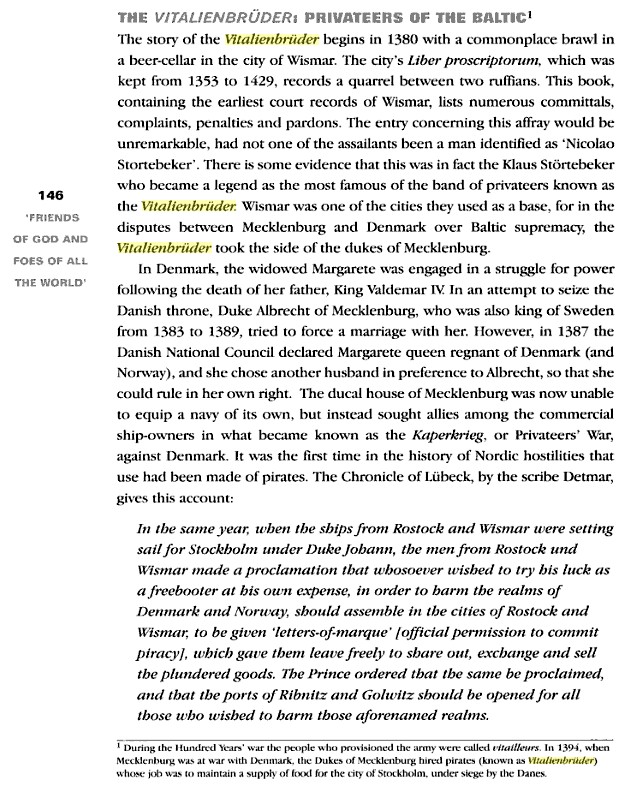
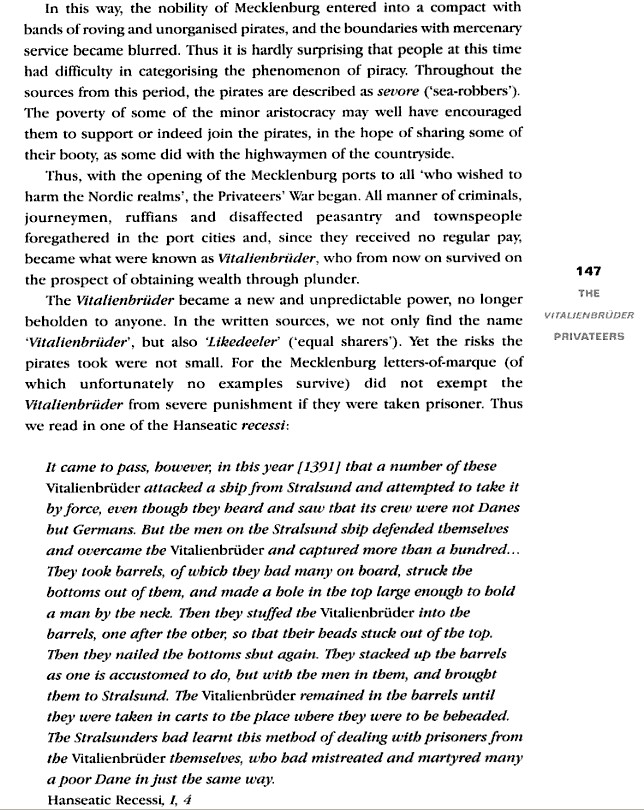
Queen Margaret became Queen of Norway/Demark and Sweden , beginning of the Scandinavian Empire...
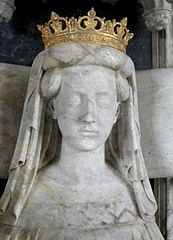 Margaret
I of Denmark - March 1353 – 28 October 1412), was Queen of
Denmark, Norway and Sweden and founder of the Kalmar
Union, which united the Scandinavian countries for over a century.
She acted as queen
regnant of Denmark, although in those days it was not the Danish custom for
a woman to reign.[2]
Her title in Denmark was derived from her father King Valdemar
IV of Denmark. She became Queen of Norway and Sweden by virtue of her
marriage to King Haakon
VI of Norway.
Margaret
I of Denmark - March 1353 – 28 October 1412), was Queen of
Denmark, Norway and Sweden and founder of the Kalmar
Union, which united the Scandinavian countries for over a century.
She acted as queen
regnant of Denmark, although in those days it was not the Danish custom for
a woman to reign.[2]
Her title in Denmark was derived from her father King Valdemar
IV of Denmark. She became Queen of Norway and Sweden by virtue of her
marriage to King Haakon
VI of Norway.
Margaret was born in March 1353, as the sixth and youngest child of Valdemar IV of Denmark and Helvig of Schleswig
Albert, King of Sweden - Albrekt av Mecklenburg in Swedish; Albrecht von Mecklenburg in German; c. 1338 – 1 April 1412) was King of Sweden from 1364 to 1389 and Duke of Mecklenburg-Schwerin from 1384 to 1412 as Albert III.
He was the second son of Duke Albert II of Mecklenburg and Euphemia Eriksdotter, the daughter of duke Erik Magnusson of Södermanland and the sister of King Magnus IV of Sweden
Eric of Pomerania - KG (1381 or 1382 – 3 May 1459) was King Eric (Eirik) III of Norway (1389–1442), King Eric VII of Denmark (1396–1439), and King Eric (Ericus)[1] of Sweden (1396–1439; known there in history mainly as Erik av Pommern). He was the first King of the Nordic Kalmar Union, succeeding his adoptive mother Margaret I of Denmark.
Background - Timeline List of Outlawe's of the Sea :
1230 - 3 May - King
Henry
III leads an army to France,
and marches on Bordeaux.
1230
- Peter
- Petrus le Utlage de Depa (Dieppe France) - ship license -
Patent Rolls of Henry III - Dieppe,
Seine-Maritime
1385 - Operation of the ferry to West Lynn was farmed to Thomas Outlagh for 13s.4d.
1393 - Licence for Sweyn (Swenoni) Stalefote, envoy and commissioner of the queen of Norway, to hire three large vessels of war in the port of Lenn, viz. one of which John Wysebech is master, one of which James Fobbyng is master, and one of which Adam Outlawe is master, and for the masters and crew to transport themselves therein with the said Sweyn. [Fadera.] By K. & C. - 1393 April 20. Westminster - 16 Richard II - (Swedish Mecklenburg pirating / privateering war with Norway and the Hanse League began 1391)
1399 - Thomas Outlawe purchased the right of a little ferry boat for 13s. 4d. from the Gild of Corpus Christi
1468 - Robert
Deryng of Lynne, maistre of the ship called the Marye of Lynne,
wherof is owners Richard Outelawe and Aleyne Thomsone, satth, he sailed from
the towne of Lynne towardes Pruce in Dantzike - DRÁP BJÖRNS. -
VERZLUN
1481 - Feoffment
by Adam Outlawe of West Lynn, chaplain, to John
Dawson of Northlenn, chaplain, 1 September 1481 Thomas
de Acre's chantry and which were granted with other lands by William Walton,
esquire, to Adam Outlawe and
John Harold of North Lynn, shipmaster
1481 - 1st Duke of Norfolk - Lord John Howard, commanded the fleet in the war with Scotland with great success - In the late spring of 1481 John Lord Howard sailed into the Firth of Forth destroying and capturing Scottish ships and burning Blackness - Mary of Lynne - take mariners for the said ship, as the king has ordered an armed force to go to sea to resist his old enemy the king of Scots. - The schippes that foloweth goeth to Scotland with the Lord Howard - The Mary of Lynne
| - - - - -
1533 - London and Middlesex Fines: Henry VIII - London & Middlesex - Adam Owtlawe, 'maryner,' - Easter Anno 25 1533
1543 - Adam
Owtlawe - send four ships to the Downes - Feb 23 - Sir Francis Bryan
to the Kings Council - Scotch prisoners
1544 - July
1544 Expedition to Calais - Captain Adam Owtlawe
1544 - Ships
- Great Shallop of Dover (Adam Owtlawe, c) - Cavendishe Shallopp
(Adam Owtlawe, c.) November 28 1544
1544 - Ships
The Newe Barke 160 t., 120 m., Adam Owtlawe. (fn. 7) - Caleis
- Greate Shalop (D.), Oct 29 1544
1544 - Owtlawe,
Adam, [no place] 21 pynnyng - Prerogative Court of Canterbury - Probate
Wills page 397 - Adam Owtlawe's Will
1548 - Thomas Outlawe - King Edward VI. issued a proclamation, A. D. Oct. 1548 - accused of piracy - 300 crown reward - In 1549 - Lord Admiral Thomas Seymour, was beheaded for reasons of state, and amongst the articles of accusation were several charging him with dealings with pirates
| - - - - -
1639 - Outlaw John - Will Deptford 1639/40p | shipwright
1647 - May
16 - Edward Cooley of Lymehouse Shipwright and Evah Outlaw, M. Marriage
- St. Dunstons Stepney Lymehouse London
1658 - Nov
16 - John Outlawe of Lymehouse Shipwright and Elizabeth Baker of
Ratcliffe, W. (marriage) W.=Widow - St. Dunstons Stepney Lymehouse
London
1661 - Captain
Thomas Outlaw - The Blessing of London - arrives in Boston
1665 - Capt.
John Outlaw sails
"The Olive Branch" ship of six guns with 96 men of crew back to
Virginia from Florida. Part of Edward Morgan's fleet preparing to attack
the Dutch West Indies
1682 - Captain
John Outlaw - serves as mate on the Bachelor’s Delight, HBC -
Hudson Bay Company , commanded by Benjamin Gillam* who sailed from New
England to the the Nelson River
1692 - Captain John Outlaw (Jean Outelas) married Françoise Denis - Boucherville, Quebec
1711 - The
Salamander, John Ralph, master,
was built for the coastal trade and for no other service in the Elizabeth River,
Virginia about 1707 for Lewis Connor, a merchant.
In April 1708 molasses and sugar were laden on the ship in the James
River. Given a permit to sail to
the Potomac, no further security was needed for such a trip.
The sloop was seized in the Potuxon River in Maryland.
EDWARD
OUTLAW, ship’s carpenter and builder of the Salamander,
filed a two page deposition on July 30, 1711 in the case.
found: KENT WILLS TO 1650
Owtelaw Thomas - Milton 1501pa
|R 6*.63 | m;
Outlaw John - Deptford
1639/40p |R 22.352 30 | shipwright
---- > Go to Outlawe Research Journal Page 2